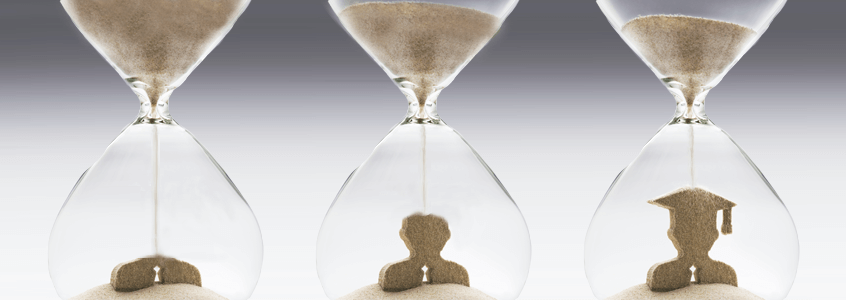
by NSC Research Center | Apr 10, 2025 | 2025, Completions, National, Postsecondary, Undergraduate Degree Earners Report
The Undergraduate Degree Earners Report provides a demographic and education credential profile for all students who graduate with an undergraduate-level credential, encompassing undergraduate certificates and associate and bachelor’s degrees. In this report, we profile students who earned undergraduate credentials during the most recent academic year (2023-24), focusing on first-time completers versus those with a prior award.

by NSC Research Center | Dec 12, 2024 | 2024, Completions, National, PDP, Postsecondary
The PDP Insights report focuses on students’ first year credit completion ratio (CCR) and credit accumulation rate (CAR). These early momentum measures can offer insights into students’ progression toward degree completion and provide indicators of when and where gaps in ultimate degree attainment between groups may begin.

by NSC Research Center | Dec 4, 2024 | 2024, Completions, National, Postsecondary, State
The Yearly Progress and Completion report contains many elements previously published in the NSC Research Center’s two primary reports focused on student progress toward credential attainment, Yearly Success and Progress and Completing College. This report combines the year-over-year look at a cohort’s journey toward completion (Yearly Success and Progress) with the in-depth analysis of six-year and eight-year cohort completion rates (Completing College) into an interactive dashboard.

by NSC Research Center | Nov 29, 2023 | 2023, Completions, National, Postsecondary, Signature Report, State
The Completing College report series provides a comprehensive overview of postsecondary completion trends nationally and by state. For all students who enter postsecondary education for the first time each year, it examines the diverse pathways the student traversed toward completion, as well as a degree or certificate completion rate within six and eight years of enrolling.

by NSC Research Center | Mar 6, 2019 | 2019, Completions, Postsecondary, Signature Report, State
In the state supplement to our seventh annual report on national college completion rates, we take a state-by-state look at the six-year outcomes for students who began postsecondary education in fall 2012.

by NSC Research Center | Feb 12, 2019 | 2019, Completions, National, Postsecondary, Signature Report
This fifth annual report on national college completion rates offers a look at the six-year outcomes for students who began postsecondary education in fall 2010, toward the end of the Great Recession. It looks at the various pathways students took toward degree completion, as well as the completion rates through May 2016 for the different student types who followed each pathway.

by NSC Research Center | Dec 18, 2018 | 2018, Completions, National, Postsecondary, Signature Report
This sixth annual report on national college completion rates offers a look at the six-year outcomes for students who began postsecondary education in fall 2011. It looks at the various pathways students took toward degree completion, as well as the completion rates through June 2017 for the different student types who followed each pathway.

by NSC Research Center | Feb 27, 2018 | 2018, Completions, Postsecondary, Signature Report, State
In the state supplement to our sixth annual report on national college completion rates, we take a state-by-state look at the six-year outcomes for students who began postsecondary education in fall 2011.
According to the research, the national completion rate for the fall 2011 cohort who started in four-year public institutions was 64.7 percent. Meanwhile, in 24 states, the completion rate was higher than this national average for four-year public institutions.

by NSC Research Center | Dec 13, 2017 | 2017, Completions, National, Postsecondary, Signature Report
This sixth annual report on national college completion rates offers a look at the six-year outcomes for students who began postsecondary education in fall 2011. It looks at the various pathways students took toward degree completion, as well as the completion rates through June 2017 for the different student types who followed each pathway.

by NSC Research Center | Nov 1, 2017 | 2017, Completions, National, Postsecondary, Snapshot Report
Of all associate degrees reported to the Clearinghouse for the 2010-11 academic year, 575,067 were earned by students with no previous degrees or certificates. Within the next six academic years, 65.1 percent of these students enrolled at four-year institutions and 41.4 percent earned bachelor’s degrees.

by NSC Research Center | Aug 7, 2017 | 2017, Completions, National, Postsecondary, Snapshot Report
Of all associate degrees reported to the Clearinghouse for the 2010-11 academic year, 575,067 were earned by students with no previous degrees or certificates. Within the next six academic years, 65.1 percent of these students enrolled at four-year institutions and 41.4 percent earned bachelor’s degrees.

by NSC Research Center | Apr 26, 2017 | 2017, Completions, National, Postsecondary, Signature Report
This supplement to our Signature Report 12 provides six-year completion rates disaggregated by race and ethnicity for students who began postsecondary education in fall 2010.

by NSC Research Center | Apr 11, 2017 | 2017, Completions, National, Postsecondary, Snapshot Report
From 2006 to 2016, degree attainment in the so-called “hard sciences” increased in prevalence for both genders. Excluding social sciences and psychology, the percentage of bachelor’s degrees accounted for by S&E disciplines increased five percentage points for men, and two percentage points for women.

by NSC Research Center | Mar 29, 2017 | 2017, Completions, National, Postsecondary, Snapshot Report
In the 2015-16 academic year, 49 percent of students who completed a four-year degree were enrolled at a two-year institution at some point in the previous 10 years.

by NSC Research Center | Mar 1, 2017 | 2017, Completions, Postsecondary, Signature Report, State
In the state supplement to our twelfth Signature Report, a national study on college completion, we take a state-by-state look at the six-year outcomes for students who began postsecondary education in fall 2010.

by NSC Research Center | Jan 15, 2017 | 2017, Completions, National, Other, Persistence, Postsecondary, Transfers
Key community college metrics are provided for three areas — college access and persistence, transfer and mobility, and certificate and degree completion — which are important indicators of community college progress.

by NSC Research Center | Dec 4, 2016 | 2016, Completions, National, Postsecondary, Signature Report
This fifth annual report on national college completion rates offers a look at the six-year outcomes for students who began postsecondary education in fall 2010, toward the end of the Great Recession. It looks at the various pathways students took toward degree completion, as well as the completion rates through May 2016 for the different student types who followed each pathway.

by NSC Research Center | Sep 18, 2016 | 2016, Completions, National, Postsecondary, Signature Report
This report examines time to degree completion for a cohort of students who earned an associate degree as their first and only postsecondary degree or a bachelor’s degree as their first four-year degree between July 1, 2014, and June 30, 2015. Overall, the average time enrolled for associate and bachelor’s degree earners was 3.3 years and 5.1 years, respectively. However, as the report shows, the time required for successful degree attainment could be influenced by the pathway the student followed as well as by factors, such as stop outs and less than full-time enrollment status.

by NSC Research Center | Jun 27, 2016 | 2016, Completions, National, Postsecondary, Snapshot Report
Of all associate degrees reported to the National Student Clearinghouse for the 2009-10 academic year, 536,351 were earned by students with no previous degrees or certificates. Within the next six academic years, over 64 percent of these students enrolled at a four-year institution and 41 percent earned a bachelor’s degree.

by NSC Research Center | Feb 23, 2016 | 2016, Completions, Postsecondary, Signature Report, State
In the state supplement to our tenth Signature Report, a national study on college completion, we take a state-by-state look at the various pathways that students take to complete a college degree or certificate.

by NSC Research Center | Nov 16, 2015 | 2015, Completions, National, Postsecondary, Signature Report
Signature Report 10 from the National Student Clearinghouse Research Center provides six-year outcomes for first-time degree-seeking students, including former dual enrollment students, who started in postsecondary education institutions in fall 2009. It offers a look at the attainment rates for students who began their postsecondary education as the Great Recession was ending.

by NSC Research Center | Jun 16, 2015 | 2015, Completions, National, Postsecondary, Snapshot Report
Of all associate degrees earned in 2008-09 that were reported to the National Student Clearinghouse, 488,046 were found to be the first postsecondary credential earned by a student. Forty-one percent of these students went on to earn a bachelor’s degree within six years.

by NSC Research Center | Mar 24, 2015 | 2015, Completions, National, Postsecondary, Snapshot Report
In the 2013-14 academic year, 46 percent of students who completed a four-year degree were enrolled at a two-year institution at some point in the previous 10 years.

by NSC Research Center | Feb 23, 2015 | 2015, Completions, Postsecondary, Signature Report, State
Signature Report 8: State Supplement take a state-by-state look at the six-year outcomes for students who began postsecondary education in fall 2008, the cohort that entered college during the Great Recession.

by NSC Research Center | Jan 26, 2015 | 2015, Completions, National, Postsecondary, Snapshot Report
From 2004 to 2014, science and engineering degrees increased in prevalence for both genders. The trend was driven by growth in the so-called “hard sciences.”

by NSC Research Center | Nov 17, 2014 | 2014, Completions, National, Postsecondary, Signature Report
Signature Report 8 from the National Student Clearinghouse Research Center provides six-year outcomes for first-time degree-seeking students, including former dual enrollment students, who started in postsecondary education institutions in fall 2008. This is the first look at the attainment rates for students who began their postsecondary education during the Great Recession.

by NSC Research Center | Mar 19, 2014 | 2014, Completions, Postsecondary, Signature Report, State
In the state supplement to our sixth Signature Report, a national study on college completion, we take a state-by-state look at the various pathways that students take to complete a college degree or certificate.
by NSC Research Center | Dec 15, 2013 | 2013, Completions, National, Postsecondary, Signature Report
This second annual report on national college completions rates continues to respond to the limitations of institution-based research by focusing on student-level data, tracking the completion of postsecondary certificates and degrees among first-time degree-seeking students who started their postsecondary education in fall 2007 and tracking their enrollments nationwide for six years, through the spring of 2013. The report also introduces an enhancement to the first Completions Report by including in the cohort students who entered college with prior experience in college-level courses through dual enrollment opportunities while still in high school.
by NSC Research Center | Nov 20, 2013 | 2013, Completions, National, Postsecondary, Signature Report
This Signature Completions Extra will present the six-year outcomes for the fall 2007 cohort, not including dual enrollment students. The data will allow readers to compare the fall 2007 cohort results to the fall 2006 cohort results that were presented in November 2012 as part of Signature Report 4, the National Student Clearinghouse Research Center’s first college completion study.
by NSC Research Center | Nov 18, 2013 | 2013, Completions, National, Postsecondary, Snapshot Report
Between 2009 and 2013, students over the age of 26 showed a 25% growth rate in science and engineering bachelor’s degree completion compared to a 19% growth rate among students age 26 or under at time of completion.
by NSC Research Center | Nov 18, 2013 | 2013, Completions, National, Postsecondary, Snapshot Report
Between 2009 and 2013, S&E bachelor’s degree completions for both men and women had almost identical growth at 20% and 21%, respectively. With social sciences and psychology included, women accounted for 50% of all S&E bachelor’s degrees in both 2009 and 2013.
by NSC Research Center | Aug 6, 2013 | 2013, Completions, National, Postsecondary, Signature Report
In our fifth Signature Report, we examine an increasingly important role community colleges play in helping students attain a baccalaureate degree. As our results show, going from a two-year to a four-year institution is a very successful pathway to a bachelor’s degree for those who transfer.
by NSC Research Center | Feb 16, 2013 | 2013, Completions, Postsecondary, Signature Report, State
In the state supplement to our fourth Signature Report, a national study on college completion, we take a state-by-state look at the various pathways that students take to complete a college degree or certificate.
by NSC Research Center | Nov 15, 2012 | 2012, Completions, National, Postsecondary, Signature Report
In our fourth Signature Report, we examine the various pathways that students take to complete a college degree or certificate. Our report goes beyond traditional graduation rate calculations that focus on first-time full-time students who finish at their starting institution to provide the most comprehensive look at student outcomes on today’s campuses.
by NSC Research Center | Oct 16, 2012 | 2012, Completions, National, Postsecondary, Snapshot Report
From 2007-08 to 2010-11, the number of degrees awarded to students age 25 and older increased by 22%, compared to 17% for those under age 25.
by NSC Research Center | Sep 6, 2012 | 2012, Completions, National, Postsecondary, Snapshot Report
For many students, the path to successfully completing a degree at a four-year institution includes enrollment at one or more two-year institutions. In the 2010-11 academic year, 45 percent of all students who completed a degree at a four-year institution had previously enrolled at a two-year institution.



























